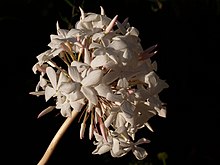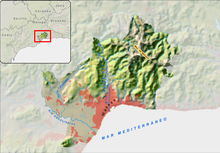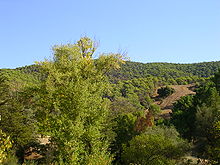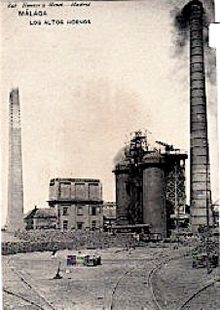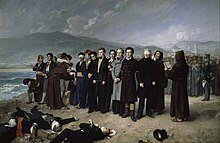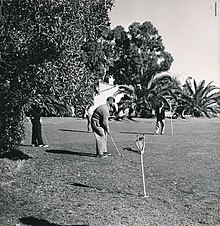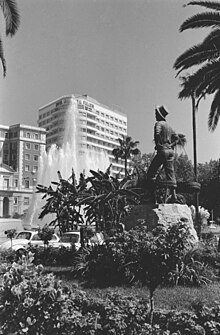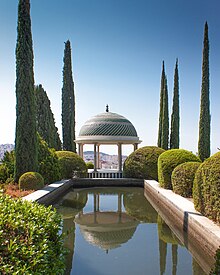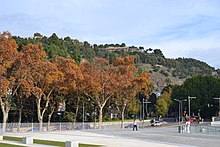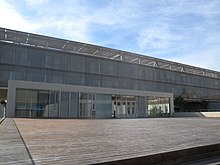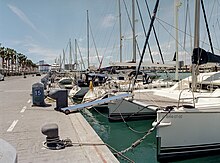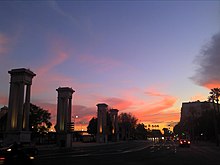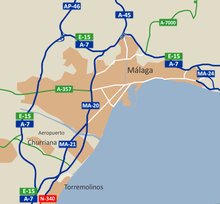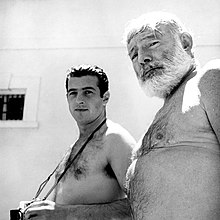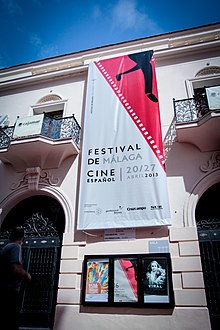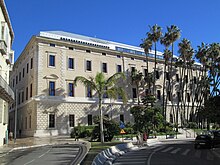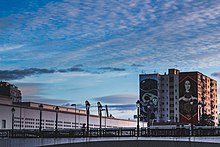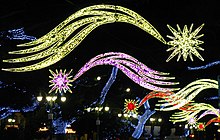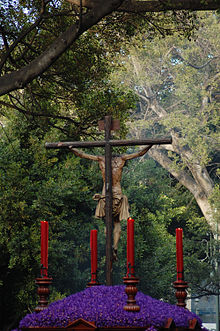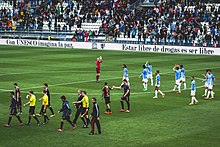Malaga
Málaga is a Spanish city and municipality, capital of the homonymous province, located in the autonomous community of Andalusia. With a population of 578,460 inhabitants as of January 1, 2020, it is the second most populous city in Andalusia and the sixth in Spain, as well as the largest among those that are not regional capitals. In addition, it is the most populous urban area. densely populated conurbation formed by the set of towns that are located along 160 km of the Costa del Sol and the center of a metropolitan area that includes another 12 municipalities that add up to 987,813 registered inhabitants. It is estimated that it makes up the fifth metropolitan area in Spain.
It is located at the western end of the Mediterranean Sea and in the south of the Iberian Peninsula, about 100 km east of the Strait of Gibraltar. Its municipal term occupies an area of 398.25 km² that extends over the mountains of Malaga and the Guadalhorce valley. It is located in the center of a bay surrounded by mountain systems: the Sierra de Mijas and the Montes de Málaga. The rivers Guadalmedina and Guadalhorce cross it.
Founded by the Phoenicians in the 8th century BC. C., is one of the oldest cities in Europe. It was first a federated municipality, then under Latin law of the Roman Empire and a prosperous Andalusian medina four times the capital of its own kingdom, which was incorporated into the Crown of Castile in 1487. During the XIX experienced a remarkable industrial and revolutionary activity that placed it as the first industrial city in Spain and made it worthy of the titles "Always bold" and "The first in danger of freedom". Scene of one of the bloodiest episodes of the Spanish Civil War and protagonist of the explosion of the tourist boom of the 1960s and 1970s, it is currently a notable entertainment, economic, cultural center and communications node on the Mediterranean coast..
Toponymy
The oldest documents that seem to mention the name of Malaga are the numismatic ones, since there must have been a mint in the area in Punic times. The word 𐤌𐤋𐤊𐤀 is mentioned on these coins, transliterated as mlkʾ. The most accepted theory is the one that derives this word from the Semitic root *m-l-k "to be king, to reign, to have dominion", perhaps indicating the presence on Malacitan soil of a temple dedicated to some goddess, probably Astarte (who is called "queen of heaven" in Semitic mythology). As early as the 17th century, the historian Martín de Roa pointed out that the name Malaca came from the Hebrew מלכה *malcah "queen", based on the quote by Strabo who considered the city "princess among the rest of this coast", and also using the philological argument that in Arabic the city had a meaning identical: "The Moors with the same name said it: Malaq i al natural della Malaqui, al rey Meliq...". If one takes into account that the founders of Malaka come from the Phoenician city of Tire and that in said the supreme god was Melqart mlk-q (king + city) and that in most of the coins found from the Malaka mint a temple appears on the reverse and the image of a god on the obverse, leads historians and experts to deduce that this temple and the name of the city were dedicated to that supreme god.
Although the Phoenician word for salt has sometimes been suggested as an etymon (cf. Hebrew מלח mélaḥ, Arabic ملح milḥ), there are phonetic problems that make this impractical. theory: the third consonant of the word “salt” in these languages is the voiceless pharyngal aspirate, but the voiceless velar plosive is used on Phoenician coins minted in Malaga (a form *𐤌𐤋𐤇𐤀 would be expected on coins). The frequent appearance of tongs engraved on the Phoenician coins minted in Málaga has given rise to deriving the name from the Semitic root *l-q-ḥ "to grab, grab, twist" with the locative preformant *m- and with a meaning "place where (the metal) is twisted", indicating the presence of some foundry. But numismatic evidence shows neither the necessary q nor ḥ (in coins one would expect *𐤌𐤋𐤒𐤇 *malqaḥ or similar).[citation required]
Symbols
"The green and purple", as the Malaga flag is known, is divided into two vertical halves, the left part purple and the right part green, with the city's coat of arms in the center. This contains in a field of blue a villa on some rocks with a port at the bottom, all over waves of the sea of silver and blue; in the right-hand corner of the chief, two figures that symbolize the patrons of the city: Saints Ciriaco and Paula; Split border of purple and sinople, loaded with four bundles of five arrows held by a yoke all of silver and a bouquet of the same metal, alternating. The Timbre is an open royal crown.
Starting in 2005, the City Council chose to represent itself with a simplified shield as an emblem, adapting to current graphic needs. Both symbols coexist, being able to find the shield or the emblem indistinctly based on the type of event or publication in which it is represented.
The motto and titles awarded to Málaga are “The first in danger of Liberty, the very Noble, very Loyal, very Hospitable, very Beneficent and always the Brave City of Málaga”. At a popular level, lyrical creation has given it the nickname of "la bella", while different songs have been nicknamed the city as "bomboniere" due to its orography, nestled between mountains.
The patron saints of Málaga are the martyrs Ciriaco and Paula and the Virgen de la Victoria. The popular and tourist emblem that characterizes Málaga is the statue of El Cenachero, which represents the missing Malaga popular trade of cenachero, a street vendor of fish. The flower that symbolizes Málaga is the biznaga, made with jasmine, the biznaguero being another popular character who was dedicated to selling biznagas on the street. Other popular symbols are the anchovy and the sardine skewers, typical fish of the city, and the Victoria Beer, made in Málaga since 1928, which called itself "Malagueña and exquisite".
Geography
The municipality of Málaga is represented on sheet 1053 of the National Topographic Map. It is bordered to the north by the municipalities of Almogía, Casabermeja, Colmenar and Comares; to the east with El Borge, Moclinejo and Totalán; to the west with Cártama and Alhaurín de la Torre; to the southeast with Rincón de la Victoria and to the southwest with Torremolinos. To the south is the Mediterranean Sea.
| Northwest: Almogia | North: Casabermeja | Northeast: Colmenar and Comares |
| West: Cartama and Alhaurín de la Torre |  | This: The Borge, Moclinejo and Totalán |
| Southwest: Torremolinos | South: Mediterranean Sea | Sureste: Rincón de la Victoria |
Relief
The municipality of Málaga spans three natural regions with different landscapes. The urban agglomeration occupies most of the Hoya de Málaga, a coastal alluvial plain formed by the estuaries of the Guadalmedina and Guadalhorce rivers. The northern half and the eastern part of the municipality correspond to the mountainous territory of the Montes de Málaga, which can reach 1032 m s. no. m. (meters above sea level) in the Cresta de la Reina. To the west stretches the Guadalhorce plain.
The city is situated at an altitude of 8 m a.s.l. no. m. and opens onto a wide bay surrounded by the southern foothills of the Montes de Málaga, which from the municipality of Rincón de la Victoria, run through the city parallel to the coast in an east-west direction and which They comprise the mountains and hills of Calderón, San Cristóbal, Victoria, Gibralfaro, Los Ángeles, Coronado, Cabello, La Tortuga and Atalaya, continuing inland along the valley of the Campanillas River. On the western side the bay is closed by the Sierras de Cártama and Mijas.
Málaga's coastline has been greatly modified by human action throughout history, some parts of the city being found on land reclaimed from the sea. In general, the beaches located to the west of the port and the mouth of the Guadalmedina are low and sandy, while to the east the coast presents a more abrupt relief, with mountainous formations very close to the coast.
Hydrography
The entire municipality falls within the Andalusian Mediterranean Basin. The watercourses are short and save large slopes, which is why they often cause torrents. The two largest are the Guadalhorce and the Guadalmedina, which collect most of the municipality's water. The irregularity of the rainfall regime results in intermittent watercourses, often being dry in summer.
Climate
The climate of Malaga is a typical Mediterranean climate, which corresponds, according to the Köppen climate classification, to the Csa Mediterranean climate. The average annual temperature is 18.5 °C, with an average maximum of 30.8 °C in August and an average minimum of 7.4 °C in January. Mildness dominates the winter climate, with frosts practically non-existent, although they lasted until the sixties and seventies of the last century XX. Summers are hot, normally humid except when "el terral" blows, a dry wind from the interior that triggers temperatures. Malaga has reached 44 °C (1953 and 1978).
Precipitation is concentrated in short periods of the year. The average humidity is 65%, with 42 rainy days a year, concentrated in the coldest months. In fact, between the months of November and January, 50% of the average annual precipitation falls, which is 534 mm. The irregularity of the rains is manifested in torrential episodes of great virulence, being the record of Malaga the 313 mm registered in the airport observatory on September 27, 1957, and the flood of November 14, 1989.
Per year, there are 2,905 hours of sunshine. In 2007, Malaga was the second sunniest city in Spain, with 3,059 hours of sunshine, according to the National Institute of Statistics, collected in its statistical yearbook. The State Meteorological Agency establishes the month of July 2009 as the warmest since 1942. In Malaga the average maximum temperature was 32 °C, with three days in a row with temperatures of 39 degrees.
| Month | Ene. | Feb. | Mar. | Open up. | May. | Jun. | Jul. | Ago. | Sep. | Oct. | Nov. | Dec. | Annual |
|---|---|---|---|---|---|---|---|---|---|---|---|---|---|
| Temp. max. abs. (°C) | 26.8 | 30.0 | 31.4 | 33.1 | 35.6 | 41.0 | 44.2 | 44.0 | 40.0 | 36.3 | 30.4 | 24.6 | 44.2 |
| Average temperature (°C) | 16.8 | 17.7 | 19.6 | 21.4 | 24.3 | 28.1 | 30.5 | 30.8 | 28.2 | 24.1 | 20.1 | 17.5 | 23.3 |
| Average temperature (°C) | 12.1 | 12.9 | 14.7 | 16.3 | 19.3 | 23.0 | 25.5 | 26.0 | 23.5 | 19.5 | 15.7 | 13.2 | 18.5 |
| Temp. medium (°C) | 7.4 | 8.2 | 9.8 | 11.1 | 14.2 | 18.0 | 20.5 | 21.1 | 18.8 | 15.0 | 11.3 | 8.9 | 13.7 |
| Temp. min. abs. (°C) | -2.6 | -3.8 | -1.2 | 2.8 | 5.0 | 9.8 | 10.0 | 12.2 | 10.2 | 5.6 | 1.4 | -0.8 | -3.8 |
| Total precipitation (mm) | 69 | 60 | 52 | 44 | 20 | 6 | 0 | 6 | 20 | 57 | 100 | 100 | 534 |
| Precipitation days (≥ 1 mm) | 5.8 | 4.8 | 4.0 | 4.5 | 3.1 | 0.8 | 0.1 | 0.5 | 2.1 | 4.4 | 5.6 | 6.6 | 42.3 |
| Hours of sun | 180 | 180 | 222 | 244 | 292 | 329 | 347 | 316 | 255 | 215 | 172 | 160 | 2905 |
| Relative humidity (%) | 69 | 68 | 67 | 63 | 59 | 58 | 58 | 61 | 65 | 70 | 71 | 72 | 65 |
| Source: State Meteorology Agency | |||||||||||||
Flora
The origin of most of the arboreal vegetation that covers the municipality is located in the reforestation carried out from the 1930s in the mountains of Malaga, in order to preserve the city from the great floods it suffered because of the Guadalmedina river. The species used in these reforestations were the stone pine, the resin pine and especially the Aleppo pine, a species that adapts perfectly to poor and highly eroded soils.
From these repopulations, the autochthonous Mediterranean vegetation began to develop and nowadays holm oaks, cork oaks and gall oaks can be seen, as well as chestnut, walnut, poplar, ash, strawberry, myrtle and carob trees, as well as various species of rockrose, heather, labiatae, hearts of palm, broom, thyme, rosemary, asparagus, etc. In the clearer areas of the pine forest, the typical Mediterranean scrub develops, with species resistant to droughts such as the erguen, the Moorish gorse, the buckthorn and the broom broom. In the shade of this scrub or under the pine forest, species such as kermes oak, kermes oak, juniper and white heather grow.
The mouth of the Guadalhorce, a small area of marshes to the south of the city, where the river forks into two arms forming a fluvial delta, contains aquatic plants, perilagoon vegetation of reeds, castanets and almajos mainly, but also poplars, eucalyptus, willows, tarajes and palm trees.
Wildlife
The mountains of Malaga support a large number of animal species. More than 151 species of vertebrates and an even larger number of invertebrates have been recorded. Amphibians include the common frog, the common toad, and the natterjack toad. Reptiles are represented by 19 species, including the chameleon, a species in serious danger of extinction, the gecko, the ocellated lizard, the lizard and snakes. Birds represent the largest group of vertebrates with almost 100 species, including birds of prey such as the goshawk, sparrow hawk, common buzzard, Bonelli's eagle, booted eagle, short-toed eagle, and the sometimes scavengers, kite. red kite, black kite, little owl, barn owl, scops owl and tawny owl.
Mammals number more than 30 species that include carnivores such as foxes, badgers, genets, mongooses, weasels, and polecats; insectivores such as the Moorish hedgehog, the blind mole, the shrew, the Etruscan shrew, which is the smallest mammal in the world, and the bat; rodents such as the field rat, the gray rat, the house mouse, the field mouse, the water vole, the molehill, the dormouse, the common vole, the squirrel, the rabbit and the Mediterranean hare; as well as the wild boar, one of the largest mammals that inhabit the mountains of the municipality.
The mouth of the Guadalhorce also contains a rich and varied fauna of birds, reptiles and amphibians, among which the Ibis, the flamingo, the spoonbill, the black stork, Audouin's gull or the red-billed pagan, in addition to others more common such as egrets, shearwaters, terns, coots and ducks. In addition, the Bay of Malaga is a breeding ground for a multitude of underwater species. In its sand, mud and rock bottoms, banks of mollusks such as clams, clams, peregrinas and corrucos develop. However, the Malaga fishing grounds are in serious decline, due to fishing pressure and immature poaching, with the most affected species being anchovy, hake, cañailla, sardines, red mullet, razor clams, scallops and coquina.
Pollution
Vehicle traffic is the main cause of pollution in the city. In 2007, a total of 125 days with high air pollution were detected, that is, Malaga experienced episodes of high pollution one out of every three days. The years of drought, which are periodic in Malaga, cause the levels of suspended particulate pollutants to increase and also other gases such as carbon dioxide or nitrogen, which in that year still did not exceed the permitted levels. Due to noise pollution, in Malaga it has been detected that the city exceeds 65.7 decibels, exceeding the levels established by the World Health Organization.
The greatest risks of contamination of the coast come from fecal waters (61.3%), oils and petroleum (32.2%), agriculture (3.2%) and radioactive compounds (3.2%). The high population density that is concentrated on the coastline of the province of Malaga leads to the production of a large amount of wastewater that is discharged into the sea. In the high tourist season the population multiplies, with the consequent increase in discharges. There are two sewage treatment plants in the municipal area, but discharges from other municipalities affect the city of Malaga, causing an increase in turbidity that makes it difficult for sunlight to penetrate, necessary for photosynthesis of plant organisms, an imbalance in aquatic communities due to excess organic matter and an increase in germs in the coastal environment, in addition to the appearance of foam and scum on the sea surface.
Demographics
With 568,507 inhabitants according to the latest data published by the INE (568,030 inhabitants as of January 1, 2011, according to municipal census statistics), the city of Málaga is the sixth largest city in terms of population in all of Spain and the second in Andalusia. The sum of the population of the municipalities that make up its metropolitan area amounts to 987,813 inhabitants.
During the 1960s there was an important migratory movement towards more industrialized European countries. However, between 1960 and 1981 the city experienced the highest demographic growth in its history, gaining around 200,000 inhabitants. Starting in the 1980s, the emigration trend was directed to the suburbs and to municipalities in its metropolitan area, mainly Alhaurín de la Torre, Cártama and Rincón de la Victoria. In 1988, Málaga suffered the segregation of the Torremolinos neighborhood, today a municipality.
| Graphic of demographic evolution in Malaga between 1842 and 2020 |
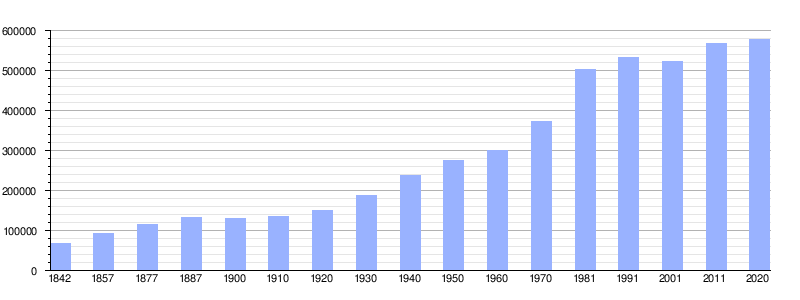 |
Source: Spanish National Statistical Institute - Graphical development by Wikipedia. |
Since the end of the XX century, Málaga has become a focus of attraction for immigrants. The number of foreign residents in 2011 is 47,925 people, 8.43% of the total, the largest communities being those made up of Moroccan, Paraguayan, Romanian, Ukrainian, Argentine, Nigerian, Italian and Chinese citizens. The community Gypsy represents less than 2%.
The majority of the city's inhabitants are of the Catholic faith. The second faith by number of adherents is Islam, especially citizens of North African origin. The Jewish community of Malaga has been in the city for almost 1,500 years and is one of the largest in Spain. Evangelicals also make their presence known in the city with multiple churches.
In 2010, the declared average income of the population of the city of Malaga was €18,588.
History
Old Age
The first colonial settlement dates back to 800 B.C. C. and 500 a. C. located at the mouth of the Guadalhorce river, on an island that was in its estuary in an enclave known as Cerro del Villar. In the place where the city is located, there was a bastulo settlement, based on which the Phoenicians founded the colony from Malaka, attracted by the good mooring conditions in its natural harbor and the large number of existing silver and copper deposits. After a period of Carthaginian domination, Malaka became part of Rome. In Roman times, the city of Málaga (in Latin Malaca) achieved remarkable development. Initially endowed with the status of a federated municipality, it obtained the status of a municipality under Latin law during the I century, after the promulgation of the "Edict of Latinidad» for Hispania by Vespasian and the promulgation by Domitian of the lex Flavia municipalis, which adapted the provisions of the municipal laws promulgated by Augustus to the peculiarities of the Latin-law municipalities of Hispania. The private copy from Malaga is called Lex Flavia Malacitana. The Roman Theatre, some large public baths and other pieces of sculpture preserved in the Archaeological Museum belong to this stage.
Roman decadence gave way to the domination of the Germanic peoples, who around the year 411 devastated the coast of Malaga. With the intention of rebuilding the Roman Empire, the Byzantine Emperor Justinian I conquered the city between 552 and 555, becoming part of the Byzantine province of Spania until 614, when it was taken by the Visigoths under the command of King Sisebuto.
Middle Ages
After the Arab conquest by Musa's son, Abd al-Aziz, Mālaqa (in Arabic مالقة) became a flourishing city surrounded by a walled enclosure next to which the neighborhoods were located. of Genoese merchants and Jewish quarters. Málaga became the capital of the Hammudí taifa, as well as of three other ephemeral kingdoms later. Traces of this period remain in the historic center and in two of its main monuments: the Alcazaba and the Gibralfaro Castle. In addition, it had two suburbs outside the walls, El Perchel and La Victoria, a business that had a discreet radius of action with Morocco and a middle class dedicated to crafts and commerce. In this stage lived the Jewish philosopher and poet Ibn Gabirol.
The capture of the city by the Catholic Monarchs in 1487 was a bloody episode in the final war against the Nasrid Kingdom of Granada. The siege of the city was one of the longest of the Reconquista, lasting six months and cutting off the food supply. The city surrendered on August 18, the kings entering in triumph the next day. The population was punished by slavery or the death penalty. Also during the siege of the city, Queen Isabella the Catholic suffered an assassination attempt. In one of the mosques, currently located on Granada street, Queen Isabel ordered the Moorish arch at the entrance to be covered, and she ordered the construction of two Christian arches on the sides, turning this mosque into a church and nicknamed it: Santiago Matamoros.[citation required]
Modern Age
Under the Castilian influence, the city began to change its urban layout and began the construction of the Cathedral of Malaga, whose architect was Diego de Siloé, on the foundations of the main mosque. The churches and convents built outside the walled enclosure began to bring together the population, giving rise to the formation of new neighborhoods outside the walls such as La Trinidad or Capuchinos.
From 15th century to XVIII the city entered a period of instability, not only due to the consequences brought about by the uprising of the Moors and their subsequent expulsion, but also due to the floods caused by the Guadalmedina river, which were accompanied by several successive bad harvests during the 17th century, as well as epidemics, earthquakes, explosions of gunpowder mills and the conscription of soldiers.
The Civitates considered Malaga an emporium of wealth, due to its privileged commercial enclave. Its agricultural products, especially wines and raisins, as well as its prized glazed vessels, attracted a great influx of foreign merchants of different nationalities; Flanders, England and France mainly traded in wood, fabrics and wheat, carrying out an important exchange of different merchandise. Commercial dealings were carried out mainly during "la vendeja".
Málaga, being the headquarters of the General Captaincy of the Coast and the Kingdom of Granada, played an essential role in the foreign policy of the Bourbons. The armies, the supply of North African prisons and the defense of the Mediterranean were organized in the city. This implied a huge expense in defense: Fortification of the port, towers on the coast and regiments of militias. In addition, the loss of Gibraltar in 1704 at the hands of the British deposited one of the keys to the Strait in Malaga.
During the second half of the XVIII century the chronic water supply problems suffered by Malaga were solved with the completion of one of the most important engineering projects carried out in Spain in that century: the San Telmo Aqueduct.
19th century
In the first years of the century, Malaga would have a leading role in the Spanish War of Independence; would contribute decisively to the first victory of a European army in the open field over Napoleon's troops in the battle of Bailén, with thousands of volunteers and, at the head of the Spanish troops, its Governor, General Teodoro Reding. In 1810, Napoleonic troops penetrated southern Spain again, the city being occupied until 1812 and having to pay large taxes for having been the only southern capital to rise up against them.
For much of the century, Malaga was one of the most rebellious cities in the country, contributing decisively to the triumph of liberalism in Spain. So much revolutionary activity earned her the title "always valiant" and the legend "the first in danger of freedom".
It was one of the first cities on the peninsula to fully experience the Industrial Revolution, becoming the first industrial city in Spain, and then holding second place after Barcelona for years. Commercial activities also had a significant increase and from 1860 to 1865 communications suffered a great revolution. At this time, the great bourgeois families of Malaga developed, some of them with influence in national politics. Under their influence, Málaga enjoyed two well-defined sectors, both located outside the center of medieval origin: at the western end, the urban landscape that began to take shape influenced by industrial activity, while at the other end of the city began to appear villas and hotels.
With the resignation of the throne of Amadeo de Saboya, great disturbances take place and the canton of Málaga is declared. Malaga's political life during the democratic six-year term was characterized by a radical and extremist tone. Federal republicanism achieved strong support in the popular classes and encouraged insurrections that caused great alarm among the wealthy sectors.
The decline of the city began in 1880. The crisis closed the Malaga foundries and was accompanied by the collapse of the sugar industry and the phylloxera plague, which sank the Malaga vineyard. The abandonment of these farms brought with it heavy deforestation of the slopes, which caused an increase in floodwaters, which caused many disasters and deaths until well into the century XX.
20th century
The beginning of the XX century is a period of economic readjustments in which there is a progressive industrial dismantling and an erratic behavior of the commercial activity. All this, within a backward and scarcely literate society, in which a now weak oligarchy exercises economic and political control. Social conflict, economic depression and weak government structures were the main problems that made republicanism and the labor movements strengthen their presence in the city.
In 1931, after the proclamation of the Second Spanish Republic, Malaga was the Spanish city most affected in the tragic events caused by anti-clericals and left-wing extremists, between May 10 and 13, known as the burning of convents. In 1933, the first deputy of the Communist Party of Spain left Malaga, due to this and the large number of active militants related to socialism, anarchism and communism, during this time Malaga was called "Málaga la Roja" despite the liberal and conservative sectors of the city, whose presence was also large.
After the outbreak of the Civil War, the city remained under Republican control until early 1937, when Franco's army, with the help of Italian volunteers and under the orders of General Queipo de Llano, launched an offensive against the city which was occupied on February 7. The subsequent repression was one of the harshest and cruelest of the war, estimated at some seventeen thousand shot, buried in common graves such as those in the San Rafael cemetery.
During the dictatorship of Francisco Franco, Málaga experienced a strong demographic expansion, caused by immigration from different parts of the province to the capital itself, and economic expansion, motivated by the tourist boom of the Coast del Sol. There were also migratory flows to other areas of Spain and Central Europe.
During the first Franco regime, Malaga was administered by the civil governor, the mayor, and the president of the Provincial Council. These three positions were the legal intermediaries between General Franco and the province, being people from the dictator's circle of trust who had been placed in said positions by himself. There was also some activity from the only legal party at the time known as the Falange, led by a provincial head of the Movement who was usually the same person who held the post of civil governor. However, the role of the Falange was reduced to a simple bureaucratic apparatus that supported Franco ideologically while trying to imitate the Italian Fascist party. After the end of World War II, the Falange declined to the detriment of Acción Católica, with Franco himself progressively reducing the role of the party to the detriment of the support provided to the Catholic Church, which now acquires significant legitimacy.
With the parliamentary monarchy and the Constitution of 1978, Malaga experienced a cultural and economic development in the south of Spain and the Mediterranean in the new century, being the city with the greatest economic activity in all of Andalusia.
Urbanism
The coastline of the Mediterranean Sea, the Guadalmedina River and the proximity of the Montes de Málaga are established as the main physical elements that have conditioned the urban configuration of Málaga. A sample of the fact is the eastern part of the city, which is a narrow and long strip of land enclosed between the sea and the mountains.
During the 18th and XIX the bulk of what is known as the Historic Center is configured, to the east of the Guadalmedina river. It is characterized by having an irregular layout inherited from the Muslim era. Among its buildings, houses several centuries old are mixed, with different degrees of conservation, some of them in ruins or in the process of being restored, with nineteenth-century buildings and others of recent construction.
In the eastern neighborhoods, with the exception of the Malagueta neighborhood, single-family homes predominate, ranging from traditional fishermen's houses, to villas with gardens in the Pedregalejo and El Limonar neighborhoods, a legacy of the industrial bourgeoisie from the XIX century. At the eastern end is the neighborhood of El Palo, an enclave that has partly preserved the image of traditional, Mediterranean and seafaring Málaga.
On the west bank of the Guadalmedina was the urban suburb and the industrial area, a residential area for workers and the popular classes until the middle of the century XX, with the exception of the neighborhood of El Perchel, which was an Arab suburb prior to the Reconquest. The rural exodus, as in the rest of Spain, began in the late 50s, and orchards, dairy farms and old industrial complexes were replaced by working-class neighborhoods inhabited by young people in search of job opportunities related to the boom tourist and industrial. This boom resulted in poorly planned and hasty urban planning, with great deficiencies in infrastructure, services and necessary equipment. Until well into the 1990s, the typical corralones existed in those areas, small multi-family homes that were They overlook a projecting gallery around a central courtyard or square, with a well or fountain in the center, some of which still survive in the neighborhoods of El Perchel and La Trinidad.
Paradoxically, the European Commission selected the city of Malaga for inclusion among the "good urban development practices" that received Urban Funds in the period 2007-2013, despite the fact that, subsequently, high-risk areas have been urbanized environmental value such as Limonar Alto, where hundreds of carob and olive trees have been felled, and channeled the Toquero stream, a habitat for chameleons and threatened amphibians. Málaga and San Sebastián were the only large Spanish cities chosen.
Monuments and places of interest
Málaga has been declared a Historic Site, due to the set of historical elements located in the same city: Phoenicians, Punics, Romans and Arabs are concentrated in the historic center of the city, highlighting: Roman Theater, the Alcazaba, the Cathedral, among other cultural elements both outdoors and underground.
Some of its main monuments are located on Mount Gibralfaro and its surroundings. The castle that crowns the mount is preserved from the Muslim period, built during the XIV century by Yusuf I on a previous enclosure of Phoenician origin that also contained a lighthouse that gives its name to the hill (gibal al-faruh, "mountain of the lighthouse"). At the foot of Gibralfaro is the Alcazaba, a palatial fortification from the Muslim period, and on the northern slope of the Alcazaba slope, the Roman Theatre, built at the beginning of the century I in the time of Emperor Augustus.
After the Christian arrival in the city, the Cathedral of the Incarnation was built, mainly Renaissance in style, but with Baroque elements; After two centuries of work, its construction was interrupted and the lack of one of its towers has earned it the nickname "La Manquita". Among its most valuable elements, the choir stalls stand out, the work of the sculptor Pedro de Mena. Next to the cathedral is the Episcopal Palace, a classicist Baroque building with an elaborate portal-altarpiece.
Parks and gardens
Málaga Park, known simply as “el parque”[citation required], is a subtropical botanical garden parallel to the port, formed on land reclaimed from the sea, between the Plaza de la Marina, to the west, and the neo-Gothic Hospital Noble and the neo-Mudéjar bullring of La Malagueta, to the east. It is an avenue almost a kilometer long, lined with small rooms, walkways and statues, which began in 1896. It contains plant specimens from the five continents and naturally adapted to Malaga, constituting a botanical rarity in Europe. The park is flanked by monumental buildings, such as the Town Hall, the headquarters of the Bank of Spain, the neo-Mudéjar Rectorate of the University, the old Casa del Jardinero Mayor and the Palacio de la Aduana, a neoclassical palace from the XVIII headquarters of the Museum of Fine Arts, which stands out for its padded walls and the palm trees that flank its main façade.[citation needed] Next to this park are two other historic gardens: The Gardens of Pedro Luis Alonso and the terraced gardens of Puerta Oscura, which descend the southern slope of Gibralfaro.
El Palmeral de las Sorpresas establishes a promenade flanked by a unique pergola in a garden made up of palm trees, shrubs, plants and minimalist fountains, next to the sheet of water on Pier 2 of the city's port area.
The botanical heritage is completed by the Botanical Garden of the University of Malaga and four historic gardens located on the outskirts that formerly formed part of bourgeois villas and that are currently open to the public. In the far north are the La Concepción Botanical Garden and the Finca San José Gardens and in the southwest, the El Retiro Historical Garden and the La Cónsula Historical Garden.
Two important environmental enclaves are Mount Victoria and Mount Gibralfaro. Both have a large population of Aleppo pine (from repopulations carried out in the 40s-50s) with hackberries, carob trees, olive trees, almond trees, holm oaks, and numerous species of herbaceous and shrubby plants. Among the fauna, migratory birds that can be observed during pre- and post-nuptial migrations stand out, such as black kites, honey buzzards, Egyptian vultures, booted and short-toed eagles, in addition, among the nesting birds we find hoopoes, gray flycatchers, sardinian and blackcap warblers, common treecreeper, common jay, common blackbird, house sparrow among others. The herpetofauna is made up of the common gecko, Iberian lizard, chameleon, ashen lizard, common and natterjack toads (perhaps locally extinct after the destruction of the Toquero stream). Mammals include the common squirrel and the common hedgehog.[citation needed]
Historic Center
The Alameda Principal, the main artery of the historic center and was configured during the XVIII century. It has several points of interest such as the Antigua Casa de Guardia tavern, an establishment with a century and a half of history where typical Malaga wines are served, the Edipsa building or the house where the Danish writer Hans Christian Andersen stayed during his stay in the city, who has a dedicated statue.[citation needed]
Marqués de Larios street, a legacy of the urban planning of the nineteenth-century city, is a road opened in 1891 originally created to connect the Plaza Mayor (today Plaza de la Constitución) with the Port of Malaga. Flanked by a series of buildings in the style inspired by the Chicago School, it is the scene of the main events of the city.
The center has two spaces dedicated to the artist Picasso: the Casa Natal de Picasso, located in Plaza de la Merced, which houses the foundation of the same name and where objects from his childhood are preserved, and one of the three museums about the artist, the Museo Picasso Málaga. In addition, some of the fountains of Málaga are located in the historic center and its surroundings as well as modern sculptures, such as Points of view.
Between the Plaza de la Merced and the Plaza de la Aduana is Alcazabilla street. Which concentrates the Customs Palace, the access to the Alcazaba, the Roman Theater, part of the city's Jewish quarter, the wooded garden at the back of the Picasso Museum and the Palace of the Counts of Buenavista, whose basement contains remains of the ancient Phoenician city wall.
Religious architecture
In Malaga apart from the Cathedral there are examples of religious architecture of different styles. The oldest that remain date from the years after the capture of the city by the Catholic Monarchs in 1487, these works being four temples within the old walled perimeter, which are: the church of San Juan, the church of the Martyrs, that of Santiago and that of San Lázaro. The four present a Gothic-Mudejar style, the oldest being that of Santiago, founded in 1490 on an old mosque.
Next to the cathedral is the church of El Sagrario, with Gothic-Elizabethan elements, built in the XVI century.
The church of San Julián dates from the 17th century, which originated from the old Hospital de la Caridad and the church del Santo Cristo de la Salud, currently the headquarters of the Association of Brotherhoods of Holy Week, the Historical Archive and the Museum of the Brotherhoods.
By the architect José Martín de Aldehuela, two temples of neoclassical design stand out: the church of San Felipe Neri and the church of the convent of San Agustín, both from the century XVIII. Also in this century, the construction of the Basilica de la Victoria was completed, of which the set of the Camarín tower and the pantheon of the Counts of Buenavista stand out, which aesthetically stands out for its black background decoration on which skeletons and figures of the death in white plaster.
Other notable religious buildings are: the hermitage of Zamarrilla, the baroque chapel of Agua, the convent of La Trinidad, the Diocesan Seminary of Malaga, the Trinitarian church of San Pablo, neo-Gothic, the abbey of Santa Ana, the work of Gerónimo Cuervo, the Church of the Sacred Heart, the work of Guerrero Strachan commissioned by the Society of Jesus, and four other churches located in the El Perchel neighborhood: the Basilica of Hope, the Church of Santo Domingo, the Church of Carmen and the Church of Saint Peter.
Civil architecture
In Malaga's civil architectural heritage, the works carried out at the end of the XIX century and the beginning of the XX. Among the buildings from this period are the Almacenes Félix Sáenz, the Mercado de Atarazanas —a building made of iron that incorporates a Nasrid arch from the XIVth century—, Casa Lange, the "Desfile del Amor" residential building, the Salamanca Market, the Miramar Palace, the Ink Palace, the La Malagueta bullring, the Colegio del Mapa, the Board of Works of the Port and the Tabacalera, among many others. All of them use the stylistic language of the time, sometimes mixing modernist, historicist and regionalist elements at the same time.
The residential promenades of the eastern zone are where most of the wealthy classes of Malaga have their place of residence such as Villa Suecia, La Bouganvillea, Villa Cele María and Villa Fernanda, among others.
Before the XIX century are the Casa Palacio de Salinas, of Muslim origin; the Palacio de Buenavista and the Palacio de Villalón, both from the 16th century; the Zea-Salvatierra Palace, from the 17th century century; the Palace of the Marqués de la Sonora, the Baroque House of the Shipyards, the Palace of Valdeflores, the House of the Consulate and the Palace of Villalcázar, from the XVIII.
Some structures from the city's industrial past still remain, such as the Old Tarajal Sugar Mill or the Chimney of the La Misericordia thermal power plant. Notable engineering works include the San Telmo Aqueduct, the Puente de los Alemanes or La Farola, completed in 1817, then being located at the entrance to the port.
Examples of contemporary architecture are the La Equitativa Building, built in 1956, the old wholesale market that houses the Contemporary Art Center and the most recent Provincial Cultural Center, Provincial Palace, Urban Environment Observatory, Manuel Altolaguirre Library, Multiple Municipal Services Building, the Palmeral de las Sorpresas and the City of Justice.
The romantic-style English Cemetery and the neoclassical San Miguel Cemetery also stand out. In these cemeteries rest, among others, Jorge Guillén, Gerald Brenan, Jane Bowles and the architects Fernando Guerrero Strachan and Eduardo Strachan Viana-Cárdenas.
Beaches
The coastline of the municipality of Malaga has sixteen beaches of diverse nature. Next to the border with Torremolinos are the beaches of San Julián, Guadalmar and Guadalhorce, the latter within the natural setting. It's about low beaches semi-urban with dark sand. In the town center and west of the port lie the beaches of La Misericordia, San Andrés and Huelin. They are extensive beaches with a high occupancy rate. On the other side of the port are the beaches: La Malagueta and La Caleta, the first with a blue flag. Further east are the Baños del Carmen and the beaches of Pedregalejo, El Palo and El Candado. These are urban beaches bounded by U-shaped dikes and fine sand. At the eastern end are the semi-urban beaches of La Araña and Peñón del Cuervo, steep in nature, with coves and small rocky cliffs.
Archaeological sites
The two main archaeological complexes are located at each end of the city. The Cerro del Villar site is located at the mouth of the Guadalhorce River. It was discovered in the 1960s and the excavations carried out have uncovered a large Phoenician city located on an ancient island in the river delta. In the eastern area, there are a series of abundant shelters and caves known as the Prehistoric Park of Málaga or La Araña Archaeological Site, where remains of pre-Neanderthals, Neanderthals, Cro-Magnons and groups from the Neolithic and Chalcolithic have appeared. Apart from these, other remains of ancient civilizations such as the Phoenician wall and the Nasrid wall and port wall, both declared an Asset of Cultural Interest, as well as several beacon towers scattered throughout the municipal area, remains of an old defensive line along the coast.
Administration and politics
Capital
The city is the capital of the province of Málaga, and therefore the administrative entities of the provincial level and of the diocese of Málaga, a suffragan of the Archdiocese of Granada, are located there. On the part of the Government of Spain, the the Subdelegation, which reports to the Government Delegate in the autonomous community, and the Provincial Council. The Junta de Andalucía, for its part, manages, among others, the areas of education, health and employment, and maintains a provincial delegation from each one of the Government Departments and the headquarters of the Mediterranean Hydrographic District and of the public company Turismo Andaluz.
Since 2000, Málaga has managed the Urban Environment network no. IUCN); and the Coordination Project in Support of Fisheries Management in the Western and Central Mediterranean (through FAO). In addition, the city is a member of Eurocities, the Association of Cities and Regions for Recycling (ACRR), the Association for Collaboration between Ports and Cities (RETE) and the League of Phoenician and Punic Cities, among others. It also participates in various cooperation projects such as Interreg MEDOCC, with the cities of Genoa, Marseille and Lyon; Ville Emission Zero, with the Lazio region; and other projects with Nador and Tetouan.
Municipal government
The first democratic municipal elections after the restoration of democracy in Spain were held in 1979. Until then, only the National Movement existed as a single party. Since that year, only the two largest political parties in Spain have governed the city: the Spanish Socialist Workers' Party, which held the mayor's office until 1995, and the Popular Party, which has governed since then.
| Period | Name | Party |
|---|---|---|
| 1979-1983 | Pedro Aparicio Sánchez | Spanish Socialist Workers Party (PSOE) |
| 1983-1987 | Pedro Aparicio Sánchez | Spanish Socialist Workers Party (PSOE) |
| 1987-1991 | Pedro Aparicio Sánchez | Spanish Socialist Workers Party (PSOE) |
| 1991-1995 | Pedro Aparicio Sánchez | Spanish Socialist Workers Party (PSOE) |
| 1995-1999 | Celia Villalobos Talero | Popular Party (PP) |
| 1999-2003 | Celia Villalobos Talero (1999-2000) Francisco de la Torre Prados (2000-2003) | Popular Party (PP) |
| 2003-2007 | Francisco de la Torre Prados | Popular Party (PP) |
| 2007-2011 | Francisco de la Torre Prados | Popular Party (PP) |
| 2011-2015 | Francisco de la Torre Prados | Popular Party (PP) |
| 2015-2019 | Francisco de la Torre Prados | Popular Party (PP) |
| 2019- | Francisco de la Torre Prados | Popular Party (PP) |
In the 2015 municipal elections, in which 54.34% of the electorate participated (229,872 votes counted), the Popular Party (PP) was the list with the most votes with 83,353 votes, achieving 13 councillors, which means simple majority (with 16 councilors being necessary to obtain an absolute majority). In second place was the Spanish Socialist Workers Party of Andalusia (PSOE-A) with 60,048 votes and 9 councilors, followed by Málaga Ahora with 30,464 votes and 4 councilors, Ciudadanos (Cs) with 23,708 votes and 3 councilors and the coalition led by Izquierda Unida Los Verdes-Call for Andalusia (IULV-CA-CLI-AS-ALTER-MÁLAGA PARA LA GENTE) with 17,050 votes and 2 councillors.
| Political party | 2019 | 2015 | 2011 | 2007 | ||||
|---|---|---|---|---|---|---|---|---|
| % | Councillors | % | Councillors | % | Councillors | % | Councillors | |
| Popular Party (PP) | 39,62 | 14 | 36,47 | 13 | 53,46 | 19 | 51,03 | 17 |
| Spanish Socialist Workers Party (PSOE) | 32,50 | 12 | 26,27 | 9 | 24,75 | 9 | 36,28 | 12 |
| Go ahead Malaga (AM)-Malaga Now (MA)-We-United Left (IU-LV) | 10,32 | 3 | 13,33 | 4 | 10.96 | 3 | 7.21 | 2 |
| Citizens (Cs) | 7.77 | 2 | 10,37 | 3 | - | - | - | - |
- Competitions
The City Council regulates matters such as urban planning, transport, collection of municipal taxes, road safety management through the Local Police, maintenance of public roads (paving, cleaning...) and gardens. It is also responsible for the construction of municipal facilities such as sports centers, libraries and social service centers.
Territorial organization
The city is divided into eleven administrative districts, coordinated by Municipal District Boards, which in turn are subdivided into neighborhoods or industrial estates.
Consular Representation
Málaga is a city with a very old consular tradition. Testimonies of consular representatives who were already practicing in 1643 are preserved, especially as notaries of maritime cargo that left the port. Malaga currently hosts a good number of consulates of those countries with which it maintains a greater number of commercial relations, presence of residential tourism or immigrants. Some of these consulates have their headquarters in different municipalities of the metropolitan area:
- Albania
 Albania
Albania - Germany
 Germany
Germany  Saudi Arabia
Saudi Arabia- Austria
 Austria
Austria - Belgium
 Belgium
Belgium - Brazil
 Brazil
Brazil - Canada
 Canada
Canada  Chile
Chile- Denmark
 Denmark
Denmark  Ecuador
Ecuador- Slovakia
 Slovakia
Slovakia  United States
United States- Philippines
 Philippines
Philippines - Finland
 Finland
Finland - Greece
 Greece
Greece - Haiti
 Haiti
Haiti - Netherlands
 Netherlands
Netherlands - Hungary
 Hungary
Hungary  Ireland
Ireland- Iceland
 Iceland
Iceland - Israel
 Israel
Israel - Italy
 Italy
Italy - Latvia
 Latvia
Latvia - Luxembourg
 Luxembourg
Luxembourg - Morocco
 Morocco
Morocco - Monaco
 Monaco
Monaco - Norway
 Norway
Norway - Panama
 Panama
Panama - Paraguay
 Paraguay
Paraguay - Peru
 Peru
Peru - Poland
 Poland
Poland  Portugal
Portugal- United Kingdom
 United Kingdom
United Kingdom - Senegal
 Senegal
Senegal - Sweden
 Sweden
Sweden - Turkey
 Turkey
Turkey - Switzerland
 Switzerland
Switzerland - Ukraine
 Ukraine
Ukraine
- Template:UR
Citizen organizations and trade unions
In September 2007, Malaga had a total of 1,914 citizen associations, with an increase of one hundred new associations a year. The corporate purpose of these associations is varied: they range from a republican university to an astronomy society. One of the oldest is the Sociedad Excursionista de Málaga founded in 1906, together with the Rotary Club of Málaga, founded in 1927. The neighborhood associations, cultural associations, youth associations and those of parents of students stand out due to their number. Others are dedicated to the attention of social minorities, ecology or consumer rights. The majority unions in Spain are also present in the city, such as the UGT and CC.OO. among others.
Justice
Málaga is the seat of the Provincial Court and the head of the judicial district of Málaga, whose demarcation includes the city plus seventeen other towns in the Axarquía, Valle del Guadalhorce and Sierra de las Nieves regions, and has with a Dean of Courts, seven Contentious-Administrative Courts, fourteen Investigative Courts, three Juvenile Courts, three for Violence against Women, fourteen Criminal Courts, nineteen First Instance Courts, thirteen Social Courts, one Surveillance Court penitentiary, unique Exclusive Civil Registry, and two Superior Courts of Justice.
The city also houses the Contentious-Administrative and Social Chambers of the Superior Court of Justice of Andalusia. All these bodies are concentrated in the City of Justice.
Services
Education
Education in Malaga depends on the Education Council of the Junta de Andalucía, which assumes the powers of education at the regional and regional level.
Preschool, primary and secondary education
Málaga has numerous educational centers of different educational levels, including public, subsidized and private.
In the network of public centers, Malaga has 82 infant and primary education centers, 35 secondary education centers and 13 adult education centers.
University education
The University of Malaga (UMA) was founded by decree of August 18, 1972 and currently has almost 40,000 students and 2,000 researchers. Although the rectory of the University of Malaga is located in the old Post Office and Telegraph House, in the historic center of the city, most of its facilities and teaching centers are spread over two main campuses:
- In the University Campus of Teatinos, most of the technical schools and faculties are located and is in the process of expansion. It has a botanical garden, the General Library, a sports complex and the cultural center Cultural container.
- The University Campus of El Ejido was the first area where university facilities were concentrated and are currently being moved to Teatinos. However, the Faculty of Economic and Business Sciences, the Faculty of Fine Arts, the Higher Technical School of Architecture, Paraninfo and the Government Pavilion remain in it.
The University of Malaga also has various centers throughout the city, which do not belong to either of the two campuses:
- UMA Foreign Course Building, located in the old building of the Faculty of Labour Sciences in El Palo.
- Residencia Universitaria Alberto Jiménez Fraud, located in the neighborhood of La Barriguilla.
- Grice-Hutchinson Experimentation Center located next to MA-21, near San Julián.
- Nave de la calle Muñoz Rojas, aneja a la Estación de Málaga-María Zambrano, which serves for the practical classes of the Escuela Técnica Superior de Arquitectura de Málaga
The University of Malaga is the promoter, together with the University of Seville, of the Andalucía TECH project, which obtained the category of Campus of International Excellence awarded by the Spanish Ministry of Education in 2010.
Transportation
Air transportation
Málaga-Costa del Sol airport is the third airport in the Iberian Peninsula, after Barajas and El Prat, in air traffic, the fourth in Spain and the international gateway to the south of the peninsula. In 2018 it registered 141,313 flights and 19,021,704 passengers, of which 16,208,244 correspond to international flights which represents around 85% of the international traffic in the region and places it as the main communications infrastructure in Andalusia and the great gateway to it. More than 50 airlines maintain international connections with 124 cities in 31 countries, mainly in Europe, especially with the United Kingdom and Germany, but also North Africa, the Middle East and North America through New York, Toronto and Montreal, in addition to national flights to the main Spanish cities. Since 1996, a regular helicopter service has also operated between Malaga airport and Ceuta heliport, transporting around 20,000 passengers per year.
The airport is connected to the city center and to the Málaga-María Zambrano Station by the Cercanías railway line and by the A Express of the EMT, which also has a stop inside the Málaga bus station, where You can connect to other Spanish cities and the Costa del Sol.
The airport has two non-parallel runways, and since March 15, 2010 it has a third passenger terminal that was inaugurated by King Juan Carlos I.
In addition, airport users have the possibility of leaving their vehicles in a whole series of car parks located in its immediate vicinity, making it even easier to get around.
Sea transport
By sea through the Port of Malaga, the city communicates with various ports on the Mediterranean Sea, currently being the second port for tourist cruises in mainland Spain after Barcelona, although the only regular line service is the ferry that connects Malaga with Melilla. It is also a fishing and merchandise port, mainly containers, vehicles, and liquid and solid bulk. Since the 1990s, remodeling has been carried out to integrate the port into the city.
There are other sports ports: Puerto El Candado in the Eastern District and the Real Club Mediterráneo Marina.
Road network
Motorways and interurban highways
Urban motorways and access to Malaga
| MA-20 | Round West |
| MA-21 | Malaga - Torremolinos |
| MA-22 | Access to Malaga Port |
| MA-23 | South access to Malaga-Costa del Sol Airport |
| MA-24 | Access this to Malaga |
Other roads
| A-404 | Coin - Alhaurín el Grande - Alhaurín de la Torre - Churriana |
| A-7000 | Malaga - Colmenar |
| A-7075 | Malaga - Almogía - Antequera |
| A-7076 | Málaga - Campanillas |
Railway
From the new Málaga-María Zambrano de Adif Station, the capital is linked with some towns in the province, especially on the Costa del Sol and the Guadalhorce Valley, and with the Airport, through the Málaga suburban network; and with the rest of Spain with daily long-distance trains to Madrid, Barcelona and Córdoba, among other destinations.
The Málaga-Córdoba high-speed line (AVE) was inaugurated on December 23, 2007, reducing the trip to Madrid to two and a half hours. This line connects the city with Antequera-Santa Ana, Puente Genil, Puertollano and Ciudad Real. In the same way, an AVE line is established between Malaga and Seville using the Malaga-Córdoba-Sevilla routes, saving 35 minutes on the journey. In addition, with the construction of the bypass in Madrid, a direct AVE service to Zaragoza and Barcelona and other towns in Aragon and Catalonia has been inaugurated.
Regarding the Media Distancia routes, the only two routes with passenger service are destined for Seville and Ronda, both circulating through El Chorro.
On August 8, 2018, it was announced that Adif and Virgin would bring the hyperloop to Spain. Specifically, to the province of Malaga, installing a research center with an investment of 430 million euros.
| Line | Traject. | Tour | Operator |
|---|---|---|---|
| Malaga - Airport - Fuengirola | 31 km | ||
| Málaga - Álora | 38 km | ||
Subway
Line 1 and Line 2 of the Málaga Metro were partially inaugurated on July 30, 2014. These two lines link the Central District with the Carretera de Cádiz District, the most densely populated area of the city, and with the Teatinos University Campus through the Cruz de Humilladero District, another of the overpopulated areas.
| Line | Terminals | Length current | Stations current | |
|---|---|---|---|---|
| 1 | El Perchel - Andalusia Tech | 7,150 km | 11 | |
| 2 | El Perchel - Sports Palace | 4.4 km | 7 | |
City buses
The urban transport within the city is also operated by the Malagueña Transport Company SAM (![]() EMT), founded in 1884, as a Malagueña Tramroad Society. With a fleet of 261 vehicles and an average life of 6.7 years per vehicle, they are characterised by being blue. It is betting on ecological transport, using some of them natural gas and some hybrid motor microbuses. It has 43 lines, including three circulars that surround the city, and three nights, that unite each point of the city, and have as a nerve center the main Alameda. The simple ticket price is €1.30 and has a fertilizer system called Card-Bus and special monthly subscriptions for young people and students, and special retirement bonuses. Urban transport is compatible with the Transport Consortium card.
EMT), founded in 1884, as a Malagueña Tramroad Society. With a fleet of 261 vehicles and an average life of 6.7 years per vehicle, they are characterised by being blue. It is betting on ecological transport, using some of them natural gas and some hybrid motor microbuses. It has 43 lines, including three circulars that surround the city, and three nights, that unite each point of the city, and have as a nerve center the main Alameda. The simple ticket price is €1.30 and has a fertilizer system called Card-Bus and special monthly subscriptions for young people and students, and special retirement bonuses. Urban transport is compatible with the Transport Consortium card.
Intercity or metropolitan buses
From the Málaga bus station, managed by the EMT, located on Paseo de los Tilos, next to the María Zambrano train station, it connects the capital with all the municipalities of the province and the main cities of Spain and Europe.
To facilitate communications with the periphery, in February 2005 the Málaga Area Metropolitan Transport Consortium was created, which coordinates the urban bus lines of Málaga, Alhaurín de la Torre and Benalmádena, the interurban bus lines that connect the city with the municipalities of the Metropolitan Area of Malaga and Álora, and the metro. To this end, it created the Transport Card. Currently, it is also possible to pay for trips on the C-1 and C-2 suburban trains, and it can be used in the public bicycle loan system of the Malaga City Council, as well as like the rest of Transport affiliated to all the Consortiums of Metropolitan Transport of Andalusia. The vehicles have a beige corporate color and a green stripe that indicates that it is public transport in Andalusia, and the line number has three figures preceded by an M (Metropolitan).
The Presidency of the Board of Directors of the Metropolitan Transport Consortium of the Malaga Area falls to the Ministry of Development and Housing of the Junta de Andalucía, while the Vice-Presidency of said body falls to the Mayor's Office of the Malaga City Council, being the municipality with the largest population in its area, and with greater power of attraction and generation of intercity trips.
There is also a bus station at Muelle Heredia, in the center of the city, next to the port of Malaga, with destinations to various towns in its metropolitan area: Rincón de la Victoria, Vélez-Málaga, Olías, Totalán, Torremolinos, Benalmádena, Fuengirola, Campanillas, Cártama and El Sexmo.
All transport routes can be consulted at the following link
Public transport statistics
The average time people spend on public transport in Malaga, for example to and from work, on a weekday is 49 minutes, while 6% of people spend more than 2 hours all the days. The average time people wait at a stop or station is 9 minutes, while 8% of people wait more than 20 minutes each day. The average distance people typically travel in a single trip is 4.1 km, while 1% travel more than 12 km in one direction.
Public bicycle rental service
The public bicycle loan service, known as málagabici, came into operation in August 2013, generating great expectations and continuing with the project to integrate the bicycle as a means of transport in the city.
It has more than 300 bicycles distributed in the 21 stations throughout various areas of the city, with a greater presence in the neighborhoods that have a bike lane, since these stations are usually close to it.
Access to the system is with the Bus-Card of the Malaga Transport Company SAM, registration being free the first year and paying €20 from the second, added to the €5 accident RC insurance. In addition, the customer has 30 free minutes, being able to change bikes after this time or keeping the same bike, charging €0.017/min after that free half hour. Thanks to an agreement between the EMT and the Malaga Area Metropolitan Transport Consortium, the Transport Card of this entity can be used under the same conditions as the EMT card.
| Bicycle stations | ||
|---|---|---|
| Number | Name | Bicis |
| 01 | Plaza de la Marina | 24 |
| 02 | Plaza General Torrijos | 15 |
| 03 | Plaza de la Merced | 15 |
| 04 | CAC (Contemporary Art Centre) | 15 |
| 05 | Multipurpose Building (Owned Seascape) | 12 |
| 06 | Princess | 19 |
| 07 | Deputation (The Thermal) | 15 |
| 08 | Calle Martínez Maldonado (Biblioteca district) | 11 |
| 09 | Sports City (Carranque) | 22 |
| 10 | Gálvez Ginachero Avenue | 17 |
| 11 | Garden City (Police) | 17 |
| 12 | Rector | 14 |
| 13 | Avenida Andalucía | 16 |
| 14 | Bus station (Calle Roger de Lis) | 10 |
| 15 | Colonia Santa Inés | 25 |
| 16 | City of Justice | 22 |
| 17 | Paseo de la Farola | 13 |
| 18 | Calle Mármoles (calle Jaboneros) | 13 |
| 19 | Avenida Arroyo de los Angeles (Colegio Gibraljaire) | 14 |
| 20 | Barbarela | 15 |
| 21 | Baños del Cármen | 41 |
Taxis
Malaga taxis are characterized by being white with a blue diagonal stripe and the Málaga shield on the front doors. It has a fleet of 1,434 taxis spread throughout the capital. They can be stopped in the middle of the street, ordered by phone or Internet, or through the designated stops for them.
Economy
Malaga is the Andalusian city with the greatest economic activity, according to the "La Caixa Economic Yearbook 2013", reaching an index of 1678 points, which places it fourth in the national ranking by cities. It is a city of services, with a significant activity in the industry of new technologies and as the capital of the Costa del Sol it has a considerable source of income in tourism, which stimulated by the airport, considered the great intermodal center of southern Spain and of great strategic importance, the improvement of communications and new infrastructures such as high-speed rail and the Cruise Ship Station, the new cultural facilities and the Trade Fair and Conference Center, as well as the renovation of the city's hotel facilities, which places it as the best rated in Spain, has multiplied the arrival of tourists.
The strength in new technology industries is noteworthy, located mainly in the Technological Park of Andalusia. The city holds the meetings of the Málaga Valley e-27 club and is the headquarters of the International Association of Science and Technology Parks (IASP) and ETICOM (Association of Information and Communication Technology Entrepreneurs of Andalusia). Málaga registers 50% of the exports of the Andalusian ICT sector.
The city is the headquarters of the largest financial institution in Andalusia, Unicaja, and the European Finance Bank, as well as the Malaga-based children's fashion companies Mayoral and Charanga, the construction companies Sando y Vera, the company that supplies material for the industry and construction Proinco (organizer of Instalandalus, the main fair in the installation sector in Andalusia), the retail distributors of perfumery, Primor, of books, Agapea, or of pet products, Tiendanimal, the food company Ubago, technology companies Uptodown, which develops the third largest portal in the world for downloading Android applications, VirusTotal, acquired by Google in 2012, AT4 Wireless and Tedial; Grupo Vértice, Aertec, Almeida Viajes and hosts branches of multinationals such as Oracle Corporation, with its second nerve center in Europe after the one located in Dublin, Fujitsu, Accenture, TDK, Ericsson, Huawei, Bestseller, Pernod Ricard or San Miguel.
Despite the large extension of the municipal area, agricultural and forestry activities are very limited by the pressure of the human environment. Seeing the production of citrus, sugar cane, almonds and olives very limited. The municipality lacks suitable pastures for extensive livestock, so the scarce livestock is of an intensive type. More significant is the fishing sector, since the bay de Málaga is a breeding area and the port has a fleet of 503 boats, which catch anchovies, horse mackerel, sole and hake among other species.
Evolution of outstanding municipal debt
The concept of outstanding debt includes only debts with savings banks and banks related to financial credits, fixed-income securities and loans or credits transferred to third parties, excluding, therefore, commercial debt.
| Graphic of evolution of living debt of the City of Malaga between 2008 and 2021 |
 |
Living debt of Malaga City Council in thousands of euros according to data from the Ministry of Finance and Public Service. |
Culture
The city experienced a modest but significant cultural movement during the first decades of the 20th century. After the Civil War, Malaga had great deficiencies in cultural infrastructure. In those years the citadel was recovered and the Archaeological Museum and the Malaga Symphony Orchestra were created. From 1954 the Book Fair began to be held and in 1968 the Litoral magazine reappeared. Since the early 1970s, with the creation of the University of Malaga, the city slowly strengthened its equipment and activities around the arts and knowledge. This process gave rise to the configuration of a new cultural panorama with a network of first-rate museums and the organization of multiple cultural activities, driven by the city's candidacy to be the European Capital of Culture in 2016.
During the 1990s, the City Council recovered the Cervantes Theater and launched the Picasso Foundation and the Malaga Philharmonic Orchestra, the latter with the collaboration of the regional government, which also promoted the creation of the Malaga Picasso Museum. Similarly, in the 2000s, the City Council founded institutions such as the Carmen Thyssen Museum, the CAC Málaga, the Echegaray Theater, and generated initiatives such as the Málaga Spanish Film Festival (FMCE) and the White Night, in addition to collaborating on projects citizens like Soho Málaga. For its part, the Provincial Council promoted cultural centers such as La Térmica and promoted editorial policy.
In addition to the public institutions mentioned, there are other private entities dedicated to the promotion of cultural activities such as the Ateneo de Málaga, the Royal Academy of Fine Arts of San Telmo and the Unicaja Foundation. Inspired by the original Parisian model, since 2008 Malaga's Noche en Blanco has been the great nightlife of culture in the city.
Poetry and literature
In the poetic and literary field, authors such as Rafael Pérez Estrada, Salvador Rueda, María Victoria Atencia and a young generation of novelists and poets such as Antonio Soler, Aurora Luque, Álvaro García, Rafael Inglada, Francisco Fortuny, José Antonio stand out. Mesa Toré and Pablo Aranda, and authors such as the playwright Miguel Romero Esteo, National Award for Dramatic Literature in 2008.
In addition to the Book Fair held annually in June, the main literary events consist of the awarding of prizes for unpublished works. Thus, the Emilio Prados Poetry Prize and the Generation of 27 Poetry Prize are awarded each year, both granted by the Center for the Generation of 27, dependent on the provincial council, which also organizes the Enrique Llovet Theater Prize.
The city council, for its part, organizes the Málaga Novel Prize, the Málaga Essay Prize, the Ciudad de Málaga Children's Literature Prize and, together with Unicaja, the Manuel Alcántara Poetry Prize, which is the prize with the highest financial value awarded to a single poem in Spain.
Málaga is the headquarters of the Andalusian Center for Literature.
Cinema and theater
The Cervantes Theater dates from 1870 and has 1,104 seats. In addition to the Cervantes, there is the Soho Theater (formerly the Alameda Theater), the Cánovas Theater, the Gades Theater and the Echegaray Theater, the Falla Theater (inside of the Superior Conservatory of Music), the Edgar Neville Auditorium, La Caja Blanca, the Roman Theater and other scenic spaces in the Superior School of Dramatic Art, the Provincial Cultural Center and the Ateneo, as well as two open-air auditoriums: the Municipal and Eduardo Ocón. Among the spaces dedicated to the seventh art, it is worth noting the old Cine Albéniz, whose programming and management corresponds to the Malaga Festival.
The Teatro Cervantes is the venue for the Malaga Spanish Film Festival, one of the most significant cultural events in the city and on the national scene. Since 1998, the stars of Spanish cinema have been deployed annually and the Biznaga de Oro is awarded to the best feature film.
Other film festivals that take place in the city are the Malaga Fantastic Film Festival or Fancine dedicated to science fiction films and the French Film Festival of Malaga, the largest cultural event in French in Spain, organized by the Alliance French from Malaga.
From the beginning of cinematography to the present day, Malaga has served as a set for numerous productions of all kinds, both national and international: The Last of the Philippines, The Conquest of the Pacific, You Only Live Twice, The reporter, Hello, are you alone?, The Way of the English or The San Luis Rey Bridge, among others, were filmed partly or entirely in the city.
Actors and comedians
Among the most relevant actors and actresses in Málaga are: Antonio Banderas, winner of multiple awards and recounts. The comedian Dani Rovira, who in addition to being a comedian, won a Goya for best actor in 2015, the actress Mabel Escaño, who worked with important directors of Spanish and world cinema, such as Jesús Franco and Vicente Aranda, the comedian Chiquito de la Calzada or the actress Maggie Civantos, among many others.
Politics and Philosophy
In Malaga there have also been thinkers such as the philosopher Ibn Gabirol, one of the Neoplatonic thinkers of the Arab medieval tradition. And jurists such as Victoria Kent, the first woman to be registered as a lawyer in the Madrid Bar Association. To Cánovas del Castillo, an important political figure in the second half of the 19th century, among others.
Museums
The city has numerous museums, but it is the art galleries that it houses that make Malaga one of the European cities with the highest concentration of relevant art centers by number of inhabitants:
Málaga Picasso Museum and Picasso Foundation
The Museo Picasso Málaga located in the Renaissance Palacio de los Condes de Buenavista, has 276 works that cover the eight decades of creation of the Malaga genius Pablo Picasso, as well as an ambitious program of temporary exhibitions. In 2013 it received more than 400,000 visitors, 70% from abroad. It is currently the most visited museum in Andalusia.
The Fundación Picasso Museo Casa Natal is another exhibition space dedicated to Pablo Picasso. In the Plaza de La Merced, in the building where Picasso was born and lived his childhood, it treasures childhood and family memories of the painter as well as works by Picasso and José Ruiz Blasco, his father, a painter and professor at the School of Fine Arts in Malaga; also outstanding art collections specialized in the graphic work, drawing and ceramics of Pablo Picasso, as well as a documentation center, with a library specialized in the life and work of the artist.
Pompidou Center
Pompidou, has in its collection works by Frida Kahlo, Picasso, Bacon, Magritte, Leger, Max Ernst, de Chirico, Giacometti, Brancusi, Marc Chagall, Julio González, Joan Miró or Antoni Tápies, among others.
Center for Contemporary Art
The Contemporary Art Center of Malaga (CAC) was inaugurated in 2003. Conceived according to the German Kunsthaus model, it exhibits plastic and visual arts from the last third of the century XX.
It has a surface area of six thousand square meters, of which two thousand four hundred are dedicated to exhibitions. The Carmen Riera collection with authors such as Andy Warhol, Jean Michel Basquiat, Juan Muñoz, Anish Kapoor or Louise Bourgeois is part of its exhibition catalog on loan.
Among the temporary exhibitions already held, great figures on the international scene have stood out such as Louise Bourgeois, Jake and Dinos Chapman, Gerhard Richter, Paul McCarthy, Anish Kapoor, Jason Rhoades, Raymond Pettibon, Ron Mueck, Rachel Whiteread, Yoshitomo Nara, Roni Horn, Daniel Richter, Rodney Graham or Marina Abramovic.
Carmen Thyssen Museum
The Carmen Thyssen Museum, which is located in the Palacio de Villalón from the XVI century, has 267 works from the Collection Carmen Thyssen-Bornemisza and exhibits a complete tour of Spanish painting from the XIX century, complemented by a careful program of temporary exhibitions. The collection includes works by Zurbarán, Mariano Fortuny, Raimundo de Madrazo, Martín Rico, Sánchez Perrier, Joaquín Sorolla, Aureliano de Beruete, Darío de Regoyos, Ramón Casas, José Gutiérrez Solana, Ignacio Zuloaga and Julio Romero de Torres, among others..
Russian Museum Saint Petersburg
The center of the Collection of the Russian Museum Saint Petersburg Málaga, located in the old Royal Tobacco Factory of Malaga, is a sub-site of the centenary State Russian Museum of Saint Petersburg. The exhibition discourse ranges from Byzantine-inspired icons to Soviet-era socialist realism. Some of the artists that are part of the collection selected for Malaga are Isaac Levitan, Olga Rozanova, Alexander Rodchenko, Kazimir Malévich, Vasili Kandinski, Marc Chagall or Valentín Serov.
Malaga Museum
The Museum of Malaga is the fusion of the Museum of Fine Arts of Malaga, founded in 1913, with the Provincial Archaeological Museum of Malaga, from 1947, and is based in the Palacio de la Aduana.
It houses an extensive catalogue, with one of the largest painting collections in Spain, which exceeds two thousand titles, where the collection of paintings of the century stands out XIX, as well as various archaeological collections ranging from prehistory to the Muslim period, as well as a valuable set of busts, sculptures and Roman funerary pieces, among other effects, with a total of more than 15 000 references.
Its Fine Arts section includes canvases and sculptures by artists such as Luis de Morales, Luca Giordano, Murillo, Alonso Cano, Ribera, Goya, Pedro de Mena, Zurbarán, Sorolla, Federico Madrazo and Ramón Casas, as well as several of the most famous members of the so-called Malagueña School of Painting.- Moreno Carbonero, Enrique Simonet, Muñoz Degrain, José Nogales or Bernardo Ferrándiz. After some delay in its comprehensive rehabilitation work on the headquarters building, it opened its doors in December 2016.
Municipal Heritage Museum
The Municipal Heritage Museum brings together some 4000 pieces of sculpture, painting, graphic work and documentation of historical value, which show the history of the city. Also of historical and ethnographic content is the Museum of Popular Arts and Customs, founded in 1976 by the Royal Academy of Fine Arts of San Telmo, which portrays the way of life of the people of Malaga in the past and in the present.
Museums dedicated to science and technology
In the technological and scientific field, there are several museums in the city: the Alborania Museum, created in 1989 with the aim of publicizing the wealth of the Alboran Sea; the National Museum of Airports and Air Transport, with a collection related to aviation and airports, historical planes on display, historical airline advertising; the Principia Science Center, an educational center in which more than sixty interactive modules are exhibited and which has a planetarium and astronomical observatory; or the Automobile Museum that exhibits more than ninety vehicles as well as engines belonging to the Portuguese collector João Manuel Magalhaes.
Religious-themed museums
Museums dedicated to sacred art are numerous, since each Holy Week brotherhood usually has its own exhibition space. The Cathedral Museum displays some paintings of great value, such as specimens by Luis de Morales or José de Ribera, as well as small sculptures from the XVII century, liturgical ornaments and pieces of gold and ivory. For its part, the Sacred Cistercian Museum contains a collection of sculpture and painting, as well as important documentary collections.
Themed museums
In addition, there are a series of thematic museums such as the Interactive Museum of Music, with a collection of musical instruments; the Dollhouse Museum, of miniatures; the Glass and Crystal Museum, the Wine Museum or the Flamenco Museum, with a collection of guitars and historical documents of this cante.
Plastic arts
Since 1979, the activity of various groups has been deployed, including artists such as Manuel Barbadillo, Antonio Jiménez, Francisco Palma Burgos, Francisco Palma García, Dámaso Ruano, Jorge Lindell Díaz, Enrique Brinkmann and José Bonilla.
Contemporary art is dedicated to Picassian October, an exhibition organized annually by the Picasso Foundation, which includes art exhibitions, conference cycles, music festivals, symposiums and popular celebrations, as well as exhibitions on Picasso. Other appointments are organized by the various museums and private exhibition halls in the city.
In addition to the aforementioned CAC Málaga or La Térmica, the city has numerous art galleries such as Alfredo Viñas, Benedito, Taller Gravura, Arte Espacio tres, GACMA, etc. The Unicaja Foundation manages the Sala Espacio Emergente that shows the innovative art of new creators.
It is also worth noting the “MálagaCrea” contest, a municipal initiative and multidisciplinary in nature. It is a springboard for young Andalusian creators, and is made up of nine exhibitions divided into up to twenty-five different artistic modalities: fashion, visual arts, video creation, performing arts, young performers, gastronomic culture, flamenco dance, literature, comics and MálagaCrea Rock.
Music
The city has several orchestras, the best known being the Symphony, the Philharmonic and the Concerto Málaga, and several choirs, among which the Cármina Nova Choir and the Opera Choir stand out. Malaga has also contributed various groups and soloists to different genres of the Spanish music scene such as opera (Carlos Álvarez), jazz (Ernesto Aurignac), pop (Danza Invisible, Efecto Mariposa, Vanesa Martín, Anni B Sweet, Pablo Alborán, Pablo López), rock (Tabletom), flamenco chill (Chambao), copla (Diana Navarro, Miguel de Molina, Antonio Molina, etc.) or hip hop (Hablando en plata, Nazión Sur, Pinnacle Rockers, Triple XXX, Head of the M).
In addition, the Malaga City Council, through the Youth Area, annually organizes the MalagaCrea Rock cultural contest, with the aim of publicizing and promoting soloists and music bands from the province. The final is held every year at the August Fair. (Tom Cary, Icarus Crash, Jarrillo Lata or Glaciar, among others, are some of the groups that have won this contest). As of 2010, the call acquired an autonomous character, admitting bands from other Andalusian provinces to the contest.
Among the concert halls, the Velvet Club, the Eventual Music Hall, the Vivero Hall, the París 15 Hall and the María Cristina Hall, among others, stand out. And as a great annual musical event, it is worth mentioning the 101 Sun Festival, dedicated to indie rock.
Málaga is one of the cradles of flamenco, so historically it has had a great weight in this art due to the songs created in the city and in the province such as verdiales or malagueñas, to the multitude of singers who have given, as well as historical flamenco enclaves such as the El Perchel neighborhood, for these reasons the term “Málaga cantaora” was coined. Throughout the year there are numerous events and shows in different venues in the city as well as in theaters such as Alameda and Cánovas. In addition, Malaga is home to one of the oldest flamenco clubs in Spain, the Peña Juan Breva, and renowned flamenco festivals are held, such as the Bienal de Málaga en Flamenco.
Libraries and files
The city has a network of more than 40 libraries from different organizations, both public and private. The main public network of libraries is made up of those managed by the Ministry of Culture of the Junta de Andalucía and the Málaga City Council. Other libraries are owned by the banks' social works, such as Unicaja or the University of Malaga, or are dedicated to a specific field, such as the libraries of the Costa Sur Meteorological Center of the National Institute of Meteorology, the Center for Subtropical Crops, the Official College of Pharmacists, the Higher Conservatory of Music or the Seismological Observatory.
The Provincial Library of Málaga is the reference library of the central and regional administrations in the province of Málaga and is located in a provisional headquarters awaiting transfer for two decades, and is complemented by the Historical Archive Provincial and the Municipal Archive.
Crafts
Carpets, leather goods, esparto grass, palm, skin and pita, embroidery, castanets, wax, ceramics, bookbinding, guitars, jewelry, toys, metal, wooden furniture, paraffin, marble carving, are produced by hand. textile and glass works.
The ceramic tradition in Malaga was consolidated during the Andalusian period, with the so-called golden ceramics, although its origins are much older. It is worth noting the representation of figures and typical characters of the town and the pottery with vessels, flowerpots or oil lamps. Cabinet-making enjoys great recognition and there are still a good number of artisan workshops dedicated to the manufacture and restoration of furniture, musical instruments and other diverse objects. Likewise, the city has a great tradition in metal work, specializing in artistic locksmithing that is frequently exported to the Middle East.
The Nereo Shipyards deserve a special mention, dedicated to the construction of traditional boats such as the jábega, and which are in the process of being declared activity of ethnological interest by the Junta de Andalucía.
Gastronomy
Malaga cuisine is a compendium of all the gastronomy of the province and fits within the Mediterranean diet. The Espetos de Sardinas, the anchovies, both fried and in vinegar, and the fried fish made with anchovies, horse mackerel, red mullet, octopus or squid, are the most popular dishes. typical, but it is also worth mentioning the noodle casserole, the gazpacho, the gazpachuelo, the migas, the Malaga salad, the ajoblanco and the Antequeran porra, among others.
Málaga is known for its sweet wines that have been produced since ancient times. These wines are protected under the Denomination of Origin Málaga y Sierras de Málaga. In addition, Ron de Málaga and brandy are also traditional.
CAMPERO
Traditional festivals
As in almost all towns and cities in the South of Spain, Christmas, Holy Week, the night of San Juan, Carnival and the May Crosses are celebrated annually in Malaga, as well as other more recent and origin foreign as Halloween, which coincides with All Saints' Day.
Holy Week in Malaga, with images in procession on thrones carried on shoulders under poles, has been declared of international tourist interest since 1965. The most popular dedications are El Cautivo; the Virgen del Rocío, known as the Málaga Bride; the Virgin of the Dove; The Rich; La Expiración, one of Mariano Benlliure's masterpieces; the Christ of the Good Death; the Virgin of Zamarrilla; La Esperanza or the Sepulcher, on Good Friday, and would end on Easter Sunday with the departure of the Resurrected One. All of these among more than forty processions that work for a whole year not only for the day of their corresponding penitential stations, but also carry out charitable work such as the Corinto Foundation, where more than a thousand people from Malaga who are going through bad times are welcomed so that they can buy with cheaper prices.
The Festival of Nuestra Señora del Carmen is celebrated on July 16 and consists of a land procession and a subsequent maritime procession of images dedicated to the Virgen del Carmen, patron saint of sailors. There is one that is the Virgen del Carmen Coronada del Perchel who leaves the Sunday following her saint's day, from the morning towards the Cathedral, until in the afternoon, when she embarks in the port of Malaga and her subsequent procession of I return to the temple.
From the second Friday of August until the Sunday of the following week, the Malaga Fair is held, the great summer festival, which opens with a fireworks display. In it, flamenco dresses and exponents of the Andalusian horse breed parade. The daytime fair is held in the historic center of the city, with typical consumption of malacitano sweet wine and dancing to the sound of both malagueñas and verdiales, as well as the latest music in bars or on the streets of the city. At night, the fair moves to the Real del Cortijo de Torres, where, in addition to the mechanical attractions, the booths are located. Bullfights are also held in the Plaza de La Malagueta and numerous music concerts. Every Saturday of the fair there is a pilgrimage to the Basilica of Nuestra Señora de la Victoria to go see the patron saint. A large number of people go to the basilica dressed in gypsy costumes, typical of the fair.
Every 8th of September the day of the Virgen de la Victoria, the patron saint of Malaga, is celebrated.
Sports
In the western area, next to the banks of the Guadalhorce, are some of the most significant sports facilities in the city. Here is the José María Martín Carpena Sports Palace, which has an area of 22,000 m² and a capacity for 11,300 spectators, being the largest sports center in southern Spain and headquarters of the Unicaja Málaga basketball team, which plays in the Spanish league. ACB, in whose venue the Copa del Rey basketball tournaments of 2001, 2007 and 2014 have been held, among other events. In addition, the multipurpose outdoor space of the Palacio de Deportes hosted the semifinal of the Davis Cup that pitted Spain against Argentina in September 2003.
In its vicinity is the Ciudad de Málaga Stadium, a modern facility where the 2006 European Athletics Cup and the 2011 Spanish Athletics Championship were held, and where Málaga CF trains. Next to these facilities The Malaga Aquatic Center is also located, which in July 2008 hosted the European men's and women's water polo championships.
The city has another outstanding sports facility that is the Ciudad Deportiva de Carranque, which due to the multidisciplinary nature of its facilities, can accommodate the practice of numerous sports such as athletics, basketball, swimming, soccer, paddle tennis, hockey grass, etc., and where the other basketball team in the city, Clínicas Rincón, plays its games in the LEB Oro league.
La Rosaleda stadium, located at the end of Paseo de Martiricos, is the stadium of Málaga Club de Fútbol, which plays in the Second Division, with a capacity for 30,044 spectators and considered top category according to stadium infrastructure regulations of UEFA. In addition to La Rosaleda, Málaga C.F. It has the Ciudad Deportiva El Viso, which is located in the El Cónsul-Teatinos area and is the usual venue for matches by Atlético Malagueño, a Málaga CF subsidiary that plays in the Third Division.
The other flagship team in the city is El Palo F.C. which plays in the Third Division and plays its matches at the Nuevo San Ignacio Stadium in the El Palo neighborhood of Málaga and with capacity for 1000 spectators.
The city's close ties to water sports is reflected in the prestigious Real Club Mediterráneo, founded in 1873 and dean of Spanish yacht clubs. The His Majesty the King Trophy has been held at its facilities since 1943.
A traditional sporting event in Malaga is the Jábegas League, which is held annually during the months of July, August and September on different city or coastal beaches, along with other competitions such as swimming across the port.
Other sports centers that can be found in most districts: Ciudad Jardín Sports Palace, El Torcal Sports Center, Carranque Sports Planning Center, José Paterna Sports Center, AQA La Trinidad Sports Center, Pigeon Shooting Sports Center and La Mosca Sports Center.
In December the Zurich Malaga Marathon is held.
Media
The main national newspapers and television channels have offices in Malaga. The newspapers El Mundo, El País, ABC, Expansión and the main television channels are present in the city, both at the national, regional and provincial level, as well as the communication agencies EFE, CRNC and Europa Press.
The provincial newspapers published in Malaga are Sur —from the Vocento group—, La Opinión de Málaga —from Grupo Moll-Prensa Ibérica— and Málaga Hoy —from Grupo Joly—, which focuses its information on news of local and provincial interest. Among the specialized magazines Litoral stands out. The written press has a long tradition in the city, which began in the 19th century with the publication of La Unión Mercantil and continued through the 20th century with El Popular, Málaga-Costa del Sol Newspaper and other media that have already disappeared. Free press began to appear in the 1990s and in 2009 ADN, 20 Minutos and Qué! were distributed
There are numerous radio stations, while the main local television stations are Canal Málaga (municipal public broadcaster, formerly known as Onda Azul), PTV Málaga, 73 tv and 101tv Málaga. Almost all of these media have a presence on the Internet.
Twin cities
Currently, Malaga is twinned with:
- Tyre, Lebanon
- Passau, Germany
- Popayán, Colombia
- Zacatecas, Mexico
- Manila, Philippines
- Bergen, Norway
- The Aiún, Western Sahara
Previous twinning:
- Mobile, United States
Notable people
Contenido relacionado
Giovanni da Verrazzano
Alboran Island
Micoud district
